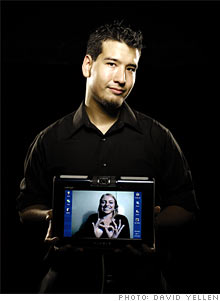Helping deaf callers connect
A communications startup takes aim at a multimillion-dollar market.
 |
| Jason Yeh's hearing-impaired workers built the first all-in-one videophone for the deaf, the VPAD. |
(Fortune Small Business) -- Jason Yeh wanted to build a communication device that at least 10% of the U.S. population would be eager to use. Early adopters would include Jason, 24, and his father, John, 61, who had just sold the family software company. The Yehs could tap into federal funding that would cover most operating costs and launch the company with a modest $1.5 million in startup capital. They had access to cheap skilled labor. And they could avoid pricey market research, because they knew their market intimately.
John and Jason - like all their employees and many of their potential customers - are deaf.
In summer 2005, Jason dropped out of the prestigious Gallaudet University in Washington, D.C., which educates deaf and hearing-impaired students. The father-and-son team set up Viable in a nearby suburb. Its products include the first videophone designed, engineered, sold, and distributed entirely by (and to) the deaf and hard of hearing.
Phone communication for the deaf has been possible since the 1960s, but for many years it was a laborious and little-used process involving teletype machines. In 1995 a new technology called video relay services (VRS) arrived. A deaf person with a videocamera would place a video call to a sign-language interpreter, who then called a hearing person.
VRS became a big business in 2002, when the FCC began collecting a monthly fee from phone users to pay for VRS cameras and interpreters (you may have noticed the charge on your telecom bill).
That fund now collects $800 million a year - and has spawned a flurry of VRS startups. The change has been revolutionary.
"For my parents these were literally the first long-range conversations they'd ever had," says Anthony Mowl, Viable's assistant vice president for business development. "There was a lot of crying on those calls."
Sorenson Communications, a giant video company based in Salt Lake City, released the first commercial VRS device, the VP-100, in 2000. The videocamera, which worked with most PCs or TVs, was given free to deaf people, enabling video relay conversations for anyone with a fast broadband connection. Sorenson currently claims about 70% of the VRS market.
But the Yehs spotted a weakness in Sorenson's business model: The company is run by the hearing. An office of deaf workers would understand the market better. Says John: "We saw room for a new type of technology company."
They started by providing better VRS services, recruiting top interpreters, and offering above-market wages. The FCC pays VRS providers about $6 a minute for calls, but the meter starts ticking only once the interpreter connects both callers. So Viable invested in speedy servers and software that would get the VRS sessions up and running as fast as possible.
Next, the Yehs formed a 20-person gadget team - headed by Jason and his college buddy Larwin Berke - to develop a dream line of products to rival Sorenson's VP-100 and its successors. The result was the VPAD, a $699 videoconferencing device that launched in January. Rather than tying the videocamera to a PC or TV like its rivals, the VPAD incorporates its camera and screen into a sleek, portable, Wi-Fi-enabled unit with very few buttons.
"We found that we don't need a feature-rich device," says Berke.
Inside Viable's immaculate (and very quiet) headquarters, mirrors at every hallway corner prevent accidental collisions. But not everything has gone smoothly. Early VPADs were buggy, testers reported, and did not play well with the web. Viable engineers claim to have ironed out most of those wrinkles. The company has racked up $7.5 million in revenue so far this year. It now boasts 95 employees.
So is Viable ... viable? "I want them to succeed," says T. Alan Hurwitz, president of the National Technical Institute for the Deaf in Rochester, N.Y. But, given the competition, "it will be a challenge." Still, Viable's staff face challenges every day. And as far as the Yehs are concerned, their rivals are impaired by hearing. ![]()
Opening New Worlds gallery: Check out these gadgets developed for the disabled that have gone mainstream.
A buzz about honey: A disabled son's obsession spawns a thriving family business.
Vision quest: How an entrepreneur turned a potentially crippling disability to his advantage.
A disabled CEO's $2 million innovation empire
-
The Cheesecake Factory created smaller portions to survive the downturn. Play
-
A breeder of award-winning marijuana seeds is following the money and heading to the U.S. More
-
Most small businesses die within five years, but Amish businesses have a survival rate north of 90%. More
-
The 10 most popular franchise brands over the past decade -- and their failure rates. More
-
These firms are the last left in America making iconic products now in their twilight. More











